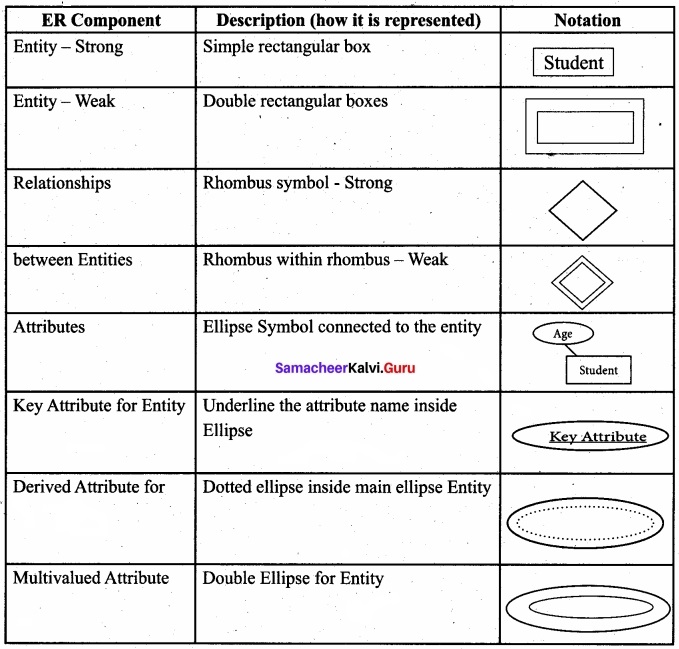Students can Download Computer Applications Chapter 3 Introduction to Database Management System Questions and Answers, Notes Pdf, Samacheer Kalvi 12th Computer Applications Book Solutions Guide Pdf helps you to revise the complete Tamilnadu State Board New Syllabus and score more marks in your examinations.
Tamilnadu Samacheer Kalvi 12th Computer Applications Solutions Chapter 3 Introduction to Database Management System
Samacheer Kalvi 12th Computer Applications Introduction to Database Management System Text Book Back Questions and Answers
PART – I
I. Choose The Correct Answer
Question 1.
Which language is used to request information from a Database?
(a) Relational
(b) Structural
(c) Query
(d) Compiler
Answer:
(c) Query
Question 2.
The ………………………. diagram gives a logical structure of the database graphically?
(a) Entity-Relationship
(b) Entity
(c) Architectural Representation
(d) Database
Answer:
(a) Entity-Relationship
![]()
Question 3.
An entity set that does not have enough attributes to form primary key is known as
(a) Strong entity set
(b) Weak entity set
(c) Identity set
(d) Owner set
Answer:
(b) Weak entity set
Question 4.
…………………………. Command is used to delete a database.
(a) Delete database databasename
(b) Delete database_name
(c) drop database database name
(d) drop database name
Answer:
(c) drop database database_name
Question 5.
Which type of below DBMS is MySQL?
(a) Object Oriented
(b) Hierarchical
(c) Relational
(d) Network
Answer:
(c) Relational
![]()
Question 6.
MySQL is freely available and is open source.
(a) True
(b) False
Answer:
(a) True
Question 7.
……………………….. represents a “tuple” in a relational database?
(a) Table
(b) Row
(c) Column
(d) Object
Answer:
(b) Row
![]()
Question 8.
Communication is established with MySQL using
(a) SQL
(b) Network calls
(c) Java
(d) API’s
Answer:
(a) SQL
Question 9.
Which is the MySQL instance responsible for data processing?
(a) MySQL Client
(b) MySQL Server
(c) SQL
(d) Server Daemon Program
Answer:
(b) MySQL Server
![]()
Question 10.
The structure representing the organizational view of entire database is known as in MySQL database.
(a) Schema
(b) View
(c) Instance
(d) Table
Answer:
(a) Schema
PART – II
II. Short Answer:
Question 1.
Define Data Model and list the types of data model used?
Answer:
Data models define how the logical structure of a database is modeled.
Data models define how data is connected to each other and how they are processed and stored inside the system. The various data models are;
- Hierarchical Database Model,
- Network Model,
- Relational Model and
- Object-oriented Database Model.
![]()
Question 2.
List few disadvantages of file processing system?
Answer:
Data Duplication – Same data is used by multiple resources for processing, thus created multiple copies of same data wasting the spaces.
High Maintenance – Access control and verifying data consistency needs high maintenance cost.
Security – less security provided to the data.
Question 3.
Define Single and multi valued attributes?
Answer:
A single valued attribute contains only one value for the attribute and they don’t have multiple numbers of values. For Example:Age-
Amulti valued attribute has more than one value for that particular attribute. F or Example :Degree
![]()
Question 4.
List any two DDL and DML commands with its Syntax?
Answer:
Commands:
- CREATE
- DROP
Syntax:
- CREATE database databasename
- DROP database databasename
DML COMMANDS List:
Commands:
- INSERT
- DELETE
Syntax:
- Syntax 1: INSERT INTO tablename (column1, column2, column3) VALUES (value 1, value2, value3);
- Syntax 2: INSERT INTO tablename VALUES (value1, value2, value3);
- DELETE from tablename WHERE columnname=”value”;
![]()
Question 5.
What are the ACID properties?
Answer:
ACID Properties – The acronym stands for Atomicity, Consistency, Isolation and Durability. Atomicity follows the thumb rule “All or Nothing”, while updating the data in database for the user performing the update operation. Consistency ensures that the changes in data value to be constant at any given instance. Isolation property is needed during concurrent action. Durability is defied as the system’s ability to recover all committed actions during the failure of storage or the system.
Question 6.
Which command is used to make permanent changes done by a trAnswer:action?
Answer:
COMMIT
Question 7.
What is view in SQL?
Answer:
Views – A set of stored queries.
![]()
Question 8.
Write the difference between SQL and MySQL?
Answer:
SQL:
- SQL is a query language
- SQL is used to query and operate database system.
MySQL:
- MySQL is DBMS software.
- MySQL allows data handling, storing, modifying, deleting, etc.
![]()
Question 9.
What is Relationship and List its types?
Answer:
In ER Model, relationship exists between two entities.
- One-to-One relationship,
- One-to-Many relationship and
- Many-to-Many relationship.
Question 10.
State few advantages of Relational databases?
Answer:
- High Availability
- High Performance
- Robust TrAnswer:actions and support
- Ease of management
- Less cost
PART – III
III. Explain in Brief Answer
Question 1.
Explain on Evolution of DBMS?
Answer:
- The concept of storing the data started before 40 years in various formats.
- In earlier days they have used punched card technology to store the data.
- Then files were used. The file systems were known as predecessor of database system.
- Various access methods in file system were indexed, random and sequential access.
- The file systems has limitations like duplication, less security. To overcome this, DBMS was introduced.
![]()
Question 2.
What is relationship in databases? List its types?
Answer:
In ER Model, relationship exists between two entities. The various types of relationships are;
- One-to-One relationship.
- One-to-Many relationship.
- Many-to-Many relationship.
Question 3.
Discuss on Cardinality in DBMS?
Answer:
Cardinality is defined as the number of items that must be included in a relationship, i.e. number of entities in one set mapped with the number of entities of another set via the relationship. Three classifications in Cardinality are one-to-one, one-to-many and Many-to-Many.

In the above example we have two entities Person and Vehicle. If we consider the current vehicle, the driver is operating, then we have one-to-one relationship between Person and Vehicle.
In the above example, Customer places the Order is a one-to-many relationship. Here the customer can place multiple orders and the order is related to only one customer. The example of many-to-many relationship is Students registering the Courses. A student can register more than one courses and A course can be registered by many students. Hence it is many-to-many.
![]()
Question 4.
List .any 5 privileges available in MySQL for the User?
List of privileges available in MySQL?
Answer:
Privileges:
- Select_priv
- Insert_priv
- Update_priv
- Delete_priv
- Create_priv
- Alter_priv
Action Performed (If Granted):
- User can select rows from database tables.
- User can insert rows into database tables.
- User can update rows of database tables.
- User can delete rows of database tables.
- User can create new tables in database.
- User can make changes to the database structure.
![]()
Question 5.
Write few commands used by DBA to control the entire database.
USE Database – This command is used to select the database in MySQL for working.
Syntax:
mysql > use test;
Database changed
mysql>
SHOW Databases – Lists all the databases available in the database server.
Syntax:
mysql > show databases;
SHOW Tables – Lists all the tables available in the current database we are working in.
mysql > show tables;
SHOW COLUMNS FROM tablename – Lists all the attributes, attribute type, Is Null value
permitted, key information, default value and other information for the given table.
Syntax:
mysql > show columns from sports;
SHOW INDEX FROM tablename – The query shows all the indexes for the given table.
Syntax:
mysql > show indexes from sports;
SHOW TABLE STATUS LIKE tablename\G – This command provides with detailed report on the performance of the table.
PART – IV
IV. Explain in detail
Question 1.
Discuss on various database models available in DBMS?
Answer:
DBMS Database Models:
The database technology came into existence in terms of models with relational and object- relational behavior. The major database models are listed below:
(i) Hierarchical Database Model The famous Hierarchical database model was IMS (Information Management System), IBM’s first DBMS. In this model each record has information in parent/child relationship like a tree structure. The collection of records was called as record types, which are equivalent to tables in relational model. The individual records are equal to rows.
In the above model we have many advantages like less redundant data, efficient search, data integrity and security. This model also has few limitations like complex to implement and difficulty in handling many to many relationships.
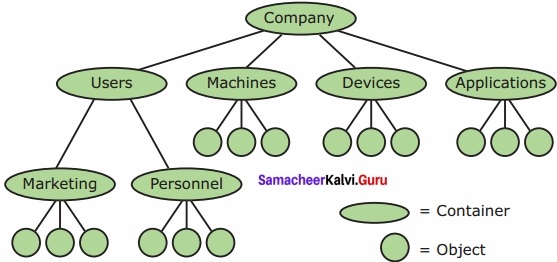
(ii) Network model:
The first developed network data model was IDS (Integrated Data Store) at Honeywell. Network model is similar to Hierarchical model except that in this model each member can have more than one owner. The many to many relationships are handled in a better way. This model identified the three database components Network schema, Sub schema and Language for data management. Network schema – schema defines all about the structure of the database.
Sub schema – controls on views of the database for the user.
Language – basic procedural for accessing the database.
The major advantage of this model is the ability to handle more relationship types, easy data access, data integrity and independence. The limitation of network model is difficulty in design and maintenance.
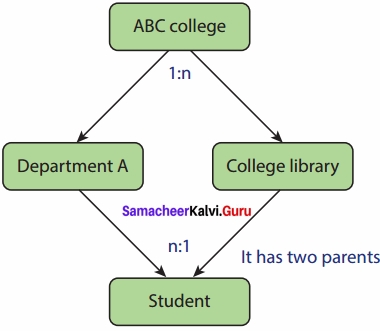
(iii) Relational model:
Oracle and DB2 are few commercial relational models in use. Relational model is defined with two terminologies Instance and Schema.
Instance – A table consisting of rows and columns
Schema – Specifies the structure including name and type of each column.
A relation (table) consists of unique attributes (columns) and tuples (rows).
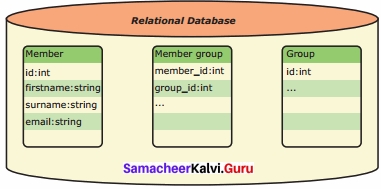
(iv) Object-oriented database model:
This model incorporates the combination of Object Oriented Programming (OOP’s) concepts and database technologies.
Practically, this model serves as the base of Relational model. Object oriented model uses small, reusable software known as Objects.
These are stored in object oriented database.
This model efficiently manages large number of different data types. Moreover complex behaviors are handled efficiently using OOP’s concepts.
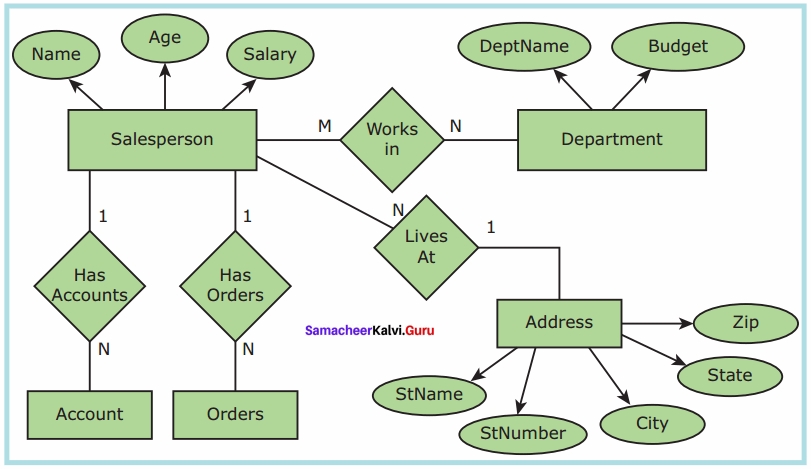
Question 2.
List the basic concepts of ER Model with suitable example?
Answer:
ER Modeling basic concepts
The basic concepts of ER model consists of
- Entity or Entity type
- Attributes
- Relationship
These are the general concepts which help to create an ER diagram and produce an ER model. With the help of these any database design can be created and viewed to know the concept in that database design.
(i) Entity or Entity type
An Entity can be anything a real-world object or animation which is easily identifiable by anyone even by a common man. Eg: In a company’s database Employee, HR, Manager are considered as entities, where each of these entity will be having their own attributes . An entity is represented by a rectangular box.

Types of Entity:
- Strong Entity
- Weak Entity
- Entity Instance
1. Strong Entity:
A Strong entity is the one which doesn’t depend on any other entity on the schema or database and a strong entity will have a primary key with it (i.e. a unique id which other entities will not have in their attributes).It is represented by one rectangle. In the above example it is a strong entity because it has a primary key(a unique id) as the roll no because for every one roll no varies and it will not be same.
2. Weak Entity:
A weak entity is dependent on other entities and it doesn’t have any primary key like the Strong entity. It is represented by double rectangle. For Example: Here the marks is the weak entity and there are no unique id or primary – key for that entity. So they are dependent on the existence of the other entity.
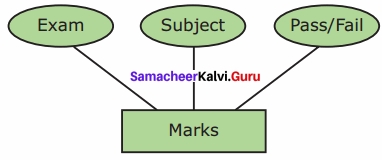
(ii) Attributes
An attribute is the information about that entity and it will describe, quantify, qualify, classify, and specify an entity. An attribute will always have a single value, that value can be a number or character or string.
Types of attributes:
- Key Attribute
- Simple Attributes
- Composite Attributes
- Single Valued Attribute
- Multi Valued Attribute
1. Key Attribute:
Generally a key attribute describes a unique characteristic of an entity.
2. Simple Attribute:
The simple attributes cannot be separated it will be having a single value for their entity. For Example: Let us consider the name as the attribute for the entity employee and here the value for that attribute is a single value.
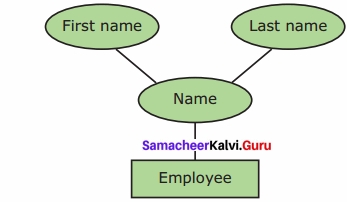
3. Composite Attributes:
The composite attributes can be sub-divided into simple attributes without change in the meaning of that attribute. For Example: In the above diagram the employee is the entity with the composite attribute Name which are sub-divided into two simple attributes first and last name.
4. Single Valued Attributes:
A single valued attribute contains only one value for the attribute and they don’t have multiple numbers of values. For Example: Age- It is a single value for a person as we cannot given number of ages for a single person,therefore it is a single valued attribute.
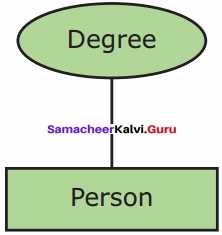
Arrtibute:
- Age
- Roll no
Values:
- 3
- 85
In the above table are the some examples for single valued attributes.
5. Multi Valued Attributes:
A multi valued attribute has more than one value for that particular attribute. For Example:
Degree – A person can hold n number of degrees so it is a multi-valued attribute.
Attributes and Values:
Attributes:
- Degree
- BankAccount
Values:
- B. Tech, MBA
- SBI, HDFC
(iii) Relationship Type:
In ER Model, relationship exists between two entities. Three types of relationships are – available and the Entity-Relationship(ER) diagram is based on the three types listed below.
(iv) One-to-One relationship:
Consider two entities A and B. one-to-one (1:1) relationship is said to exist in a relational database design, if 0 or 1 instance of entity A is associated with 0 or 1 instance of entity B, and 0 or 1 instance of entity B is associated with 0 or 1 instance of entity A.
(v) One-to-Many relationship:
Consider two entities A and B. one-to-many (1:N) relationship is said to exist in a relational database design, for 1 instance of entity A there exists 0 or 1 or many instances of entity B, but for 1 instance of entity B there exists 0 or 1 instance of entity A.
(vi) Many-to-Many relationship:
Consider two entities A and B. many-to-many (M:N) relationship is said to exist in a relational database design, for 1 instance of entity A there exists 0 or 1 or many instances of entity B, and for 1 instance of entity B there exists 0 or 1 or many instance of entity A.
In reality one-to-one are in less usage, where as one-to-many and many-to-many are commonly used. However in relational databases, many-to-many are converted into one-to- many relationships.
![]()
Question 3.
Discuss in detail on various types of attributes in DBMS?
Answer:
Types of attributes:
- Key Attribute
- Simple Attributes
- Composite Attributes
- Single Valued Attribute
- Multi Valued Attribute
1. Key Attribute:
Generally a key attribute describes a unique characteristic of an entity.
2. Simple Attribute:
The simple attributes cannot be separated it will be having a single value for their entity. For Example: Let us consider the name as the attribute for the entity employee and here the value for that attribute is a single value.

3. Composite Attributes:
The composite attributes can be sub-divided into simple attributes without change in the meaning of that attribute. For Example: In the above diagram the employee is the entity with the composite attribute Name which are sub-divided into two simple attributes first and last name.
4. Single Valued Attributes:
A single valued attribute contains only one value for the attribute and they don’t have multiple numbers of values. For Example: Age- It is a single value for a person as we cannot given number of ages for a single verson, therefore it is a single valued attribute.

Attribute:
- Degree
- Bank_Account
Values:
- 3
- 85
5. Multi Valued Attributes:
A multi valued attribute has more than one value for that particular attribute. For example:
Degree – A person can hold n number of degrees so it is a multi-valued attribute.
In the below table are some examples for multi valued attributes.
Attribute:
- Degree
- Bank_Account
Values:
- B.TEch, MBA
- SBI, HDFC
![]()
Question 4.
Write a note on open source software tools available in MySQL Administration?
MYSQL Administration open source software tools:
Answer:
Types of software tools:
Many open source tools are available in the market to design the database in a better and efficient manner. PhpMyAdmin is most popular for Web Administration. The popular Desktop Application tools are MySQL Workbench and HeidiSQL.
PHPMYADMIN (Web Admin):
- This administrative tool of MySQL is a web application written in PHP.
- They are used predominantly in web hosting.
- The main feature is providing web interface, importing data from CSV and exporting data to various formats.
- It generates live charts for monitoring MySQL server activities like connections, processes and memory usage.
- It also helps in making the complex queries easier.
MySQL Workbench (Desktop Application):
- It is a database tool used by developers and DBA’s mainly for visualization.
- This tool helps in data modeling, development of SQL, server configuration and backup for MySQL in a better way.
- Its basic release version is 5.0 and is now in 8.0 supporting all Operating Systems.
- The SQL editor of this tool is very flexible and comfortable in dealing multiple results set.
HeidiSQL (Desktop Application):
- This open source tools helps in the administration of better database systems.
- It supports GUI (Graphical User Interface) features for monitoring server host, server connection, Databases, Tables, Views, Triggers and Events.
![]()
Question 5.
Explain in detail on Sub Queries with suitable examples?
Answer:
Sub queries:
The SQL query is written within a main Query. This is called as Nested Inner/SubQuery.The sub query is executed first and the results of sub query are used as the condition for main query.
The sub query must follow the below rules:
- Subqueries are always written within the parentheses.
- Always place the Subquery on the right side of the comparison operator.
- ORDER BY clause is not used in sub query, since Subqueries cannot manipulate the results internally.
Consider the Employee table with the fields EmpID, Name, Age and Salary.
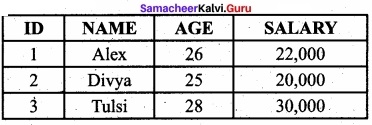
In the below Query, we use sub query in an SELECT statement.
SELECT * from Employee
where EmpID IN (SELECT EmpID from Employee WHERE Salary < 20000);
First, the inner query is executed. As a result EmpID 101 and 103 are retrieved. Now the external or outer query is executed. Internally the query is SELECT * from Employee where EmpID IN(101,103) and the output is drawn below.
Select Record List

Similarly the subqueries are used with INSERT, UPDATE and DELETE.
Samacheer Kalvi 12th Computer Applications Introduction to Database Management System Additional Question and Answer:wers
I. Choose the Best Answer
Question 1.
Expand DBMS?
(a) DataBase Management System
(b) Data Manipulation Schema
(c) Data Base Management Schema
(d) Data Base Manipulation Schema
Answer:
(a) DataBase Management System
![]()
Question 2.
Expand RDBMS.
(a) Relational Data Base Manipulation System
(b) Relational Data Base Management Schema
(c) Relational Data Base Management System
(d) Record Data Base Managing Schema
Answer:
(c) Relational Data Base Management System
Question 3.
Expand ODBMS.
(a) Object Data Base Management System
(b) Objective Data Base Management System
(c) Object Oriented Data Base Management System
(d) Objective Data Manipulation System
Answer:
(a) Object Data Base Management System
![]()
Question 4.
Update operation is otherwise called as …………………………
Answer:
transaction
Question 5.
Two types of trAnswer:action operations are ……………………… and ………………………
Answer:
commits and aborts
Question 6.
To prevent the conflict in database update, the trAnswer:actions are isolated from other user and serialized. This is called as ……………………….
(a) Atomicity
(b) Consistency
(c) Isolation
(d) Degree of Consistency
Answer:
(d) Degree of Consistency
![]()
Question 7.
ensures that the changes in data value to be constant at any given instance.
(a) Atomicity
(b) Consistency
(c) Isolation
(d) Durability
Answer:
(b) Consistency
Question 8.
Match the following:
1. Atomicity – (i) commit / aborts
2. TrAnswer:action – (ii) constant data
3. Consistency – (iii) recover all committed trAnswer:actions
4. Durability – (iv) All or Nothing
(a) 1-(iv), 2-(i), 3-(ii), 4-(iii)
(b) 1-(i), 2-(ii), 3-(iii), 4-(iv)
(c) 1 -(iv), 2-(iii), 3-(ii),4-(i)
(d) 1-(i), 2-(ii), 3-(iv), 4-(iii)
Answer:
(a) 1-(iv), 2-(i), 3-(ii), 4-(iii)
![]()
Question 9.
Concurrency control and locking are needed
(a) Consistency
(b) data sharing
(c) data hiding
(d) TrAnswer:action
Answer:
(b) data sharing
Question 10.
How many Database models are there?
(a) 2
(b) 3
(c) 4
(d) 5
Answer:
(c) 4
![]()
Question 11.
The famous Hierarchical database model was ……………………
Answer:
IMS
Question 12.
IMS stands for ……………………..
Answer:
Information Data Store
Question 13.
IBM’s first DBMS is ……………………..
(a) IMS
(b) IVS
(c) BMS
(d) VMS
Answer:
(a) IMS
![]()
Question 14.
Hierarchical database model uses …………………….. structure.
(a) star
(b) tree
(c) HoneyComb
(d) Hair like
Answer:
(b) tree
Question 15.
Parent child relationship is established in …………………….. database Models.
(a) Hierarchical
(b) Network
(c) Relational
(d) Object
Answer:
(a) Hierarchical
![]()
Question 16.
The collection of records in Hierarchical models are called as ……………………..
(a) field types
(b) tuples
(c) record types
(d) ACID
Answer:
(c) record types
Question 17.
In ACID properties I indicates
(a) Inverter
(b) Interface
(c) Isolation
(d) Identification
Answer:
(c) Isolation
![]()
Question 18.
The first Network Model was developed at ……………………..
Answer:
Honey well
Question 19.
…………………….. is the first developed Network Data Model.
(a) IMS
(b) IDS
(c) DB2
(d) OOP’s
Answer:
(b) IDS
Question 20.
IDS stands for ……………………..
Answer:
Integrated Data Store
![]()
Question 21.
Which of the two databases models are similar?
(a) Hierarchical, Network
(b) Network, relational
(c) Relational, Object oreinted
(d) Network, Object oreinted
Answer:
(a) Hierarchical, Network
Question 22.
Network database model is identified by ………………………..
(a) 2
(b) 3
(c) 4
(d) 5
Answer:
(b) 3
![]()
Question 23.
Find the Statement which is wrong?
(a) Network Schema deals with locking
(b) Subschema controls on view of the database
Answer:
(a) Network Schema deals with locking
Question 24.
Which one of the following is the basic procedural for accessing the database in Network model?
Answer:
(a) Network schema
(b) Sub schema
(c) Language
(d) Super schema
Answer:
(c) Language
![]()
Question 25.
……………….. and …………………… are the commercial relational database models.
(a) Oracle, DB2
(b) DB2, IDS
(c) IDS, IMS
(d) Oracle, IBME
Answer:
(a) Oracle, DB2
Question 26.
Find which of the following statements are true with respect to Relational model
(i) Instance – A table with rows and columns
(ii) Schema – Specifies the sjtructure
(a) (i) is true
(b) (ii) is true
(c) both are true
(d) both are false
Answer:
(c) both are true
![]()
Question 27.
Columns are otherwise called as …………………….
Answer:
attributes
Question 28.
OOP’s stands for …………………….
Answer:
Object Oriented Language.
Question 29.
Object oriented model uses small, reusable software known as ………………………
(a) objects
(b) software
(c) class
(d) private
Answer:
(a) objects
Question 30.
The vertical entity of a table is known as ………………………. or ……………………….
Answer:
Attribute, Column
![]()
Question 31.
A primary key which is a combination of more than one attribute is called a ………………………..
Answer:
composite primary key
Question 32.
Each super key is called as ……………………… key.
(a) Sub
(b) Candidate
(c) Schema
(d) Constraint
Answer:
(b) Candidate
Question 33.
What is the another name for Candidate Key?
(a) Super key
(b) Sub key
(c) Minimal super key
(d) Maximal super key
Answer:
(c) Minimal super key
![]()
Question 34.
Composite key is otherwise called as ………………………
(a) compound key
(b) super key
(c) sub key
(d) foreign key
Answer:
(a) compound key
Question 35.
How many basic concepts are there in ER model?
(a) 2
(b) 3
(c) 4
(d) 5
Answer:
(b) 3
Question 36.
How many types of entities are there?
(a) 2
(b) 3
(c) 4
(d) 5
Answer:
(b) 3
![]()
Question 37.
What is the symbol for weak Entity?
(a) square
(b) double square
(c) rectangle
(d) double rectangle
Answer:
(d) double rectangle
Question 38.
………………………. denotes the category values for the given entity.
(a) Schema
(b) Structure
(c) Entity Instance
(d) Existence
Answer:
(c) Entity Instance
Question 39.
……………………. describes a unique characteristic of an entity.
Answer:
Key Attribute.
![]()
Question 40.
How many types of attributes are there?
(a) 2
(b) 3
(c) 4
(d) 5
Answer:
(d) 5
Question 41.
How many relationship types are there in ER model?
(a) 2
(b) 3
(c) 4
(d) 5
Answer:
(b) 3
Question 42.
The number of entity types involved is known as …………………….
Answer:
degree of relationship
![]()
Question 43.
Customer places the order is an example of ……………………. relationship.
(a) one to one
(b) one to many
(c) many to many
(d) two to many
Answer:
(b) one to many
Question 44.
MySQL is founded by ……………………….
(a) My Widenius
(b) Monty Widenius
(c) Marley Minto
(d) My Minto
Answer:
(b) Monty Widenius
Question 45.
SQL meAnswer: ……………………….
Answer:
Structured Query Language.
![]()
Question 46.
The structured collection of data is ……………………..
(a) data
(b) table
(c) row
(d) database
Answer:
(d) database
Question 47.
The databases are broadly classified into …………………….. and …………………….. databases.
Answer:
Heavy, light
Question 48.
The light databases that supports the web applications are also known as ……………………. databases.
(a) web
(b) Heavy
(c) Application
(d) Super
Answer:
(a) web
![]()
Question 49.
DBA stands for ……………………..
Answer:
DataBase Administrators.
Question 50.
All the query will terminate with ……………………
(a) colon
(b) semicolon
(c) bracket
(d) dot
Answer:
(b) semicolon
Question 51.
…………………. reboots the server.
Answer:
Flush privileges
![]()
Question 52.
…………………… is the most popular web administration tool.
Answer:
Phpmyadmin
Question 53.
The popular Desktop Application tools are
(a) MySQL workbench
(b) HeidiSQL
(c) PlSQL
(d) both a and b
Answer:
(d) both a and b
Question 54.
The process of creating, implementing and maintaining the enterprise data in the system is known as ……………………… of databases.
Answer:
desingning
![]()
Question 55.
Expand Answer:
(a) American National Standards Institute
(b) African National Standard Institute
(c) American North Sound Institute
(d) All-National Standard Institute
Answer:
(a) American National Standards Institute
Question 56.
…………………… is used to temporarily save a trAnswer:action.
(a) Commit
(b) Rollback
(c) TrAnswer:action
(d) SavePoint
Answer:
(d) SavePoint
![]()
Question 57.
When we want to select data from more than 2 tables ……………………. clause is used.
(a) group
(b) merge
(c) combine
(d) sql join
Answer:
(d) sql join
Question 58.
Multiple numbers of values are not allowed in ………………………. attributes.
(a) single valued
(b) composite
(c) multi valued
(d) key
Answer:
(a) single valued
![]()
Question 59.
Match the following attributes with their values.
1. simple – (i) Degree
2. composite – (ii) Name
3. Single valued – (iii) First Name, Last Name
4. Multi valued – (iv) Age
(a) 1-(ii), 2-(iii), 3-(iv), 4-(i)
(b) 1-(i), 2-(ii), 3-(iii), 4-(iv)
(c) 1-(iv), 2-(ii), 3-(i), 4-(iii)
(d) 1-(iv), 2-(i), 3-(ii), 4-(iii)
Answer:
(a) 1-(ii), 2-(iii), 3-(iv), 4-(i)
Question 60.
…………………….. is the symbol for Relationship in ER Model.
Answer:
Rhombus
Question 61.
M : N relationship is said to be ………………………. relationship.
Answer:
many to many
![]()
Question 62.
The most popular DBMS is ……………………….
Answer:
MySQL
Question 63.
The least popular DBMS as per the statistical data is ……………………….
Answer:
cassandra
![]()
Question 64.
………………… lists all the databases available in the databases.
Answer:
Show databases
Question 65.
shows all the indexes for the given table.
Answer:
Show index from tablename
Question 66.
Match the following
1. DDL – (a) commit
2. DML – (b) alter
3. DQL – (c) insert
4. TCL – (d) select
(a) 1-(b) 2 (c) 3-(d) 4-(a)
(b) 1-(a) 2-(d) 3-(b) 4-(c)
(c) 1-(c)2-(b)3-(a)4-(d)
(d) 1-(d) 2-(b) 5-(a) 4-(c)
Answer:
(a) 1-(b) 2 (c) 3-(d) 4-(a)
![]()
Question 67.
Find the wrong one.
(a) DDL – create command
(b) DML – update
(c) TCL – solve point
(d) DCL – select
Answer:
(d) DCL – select
Question 68.
DDL stands for ……………………….
Answer:
Data Definition Language
Question 69.
DML stands for ……………………….
Answer:
Data Manipulation Language
![]()
Question 70.
DQL stands for ……………………….
Answer:
Data Query Language
Question 71.
TCL stands for ……………………….
Answer:
Transaction Control Structure
Question 72.
DCL stands for ……………………….
Answer:
Data Control Language
![]()
Question 73.
………………………. clause is used in select and update query statement for the condition.
Answer:
where
Question 74.
The existing record in a table is removed from the table using ………………………. command.
Answer:
DELETE
Question 75.
………………………. is not a logical operator.
(a) And
(b) Between
(c) Plus
(d) Unique
Answer:
(c) Plus
![]()
Question 76.
IN is ………………………. operator.
Answer:
logical
Question 77.
<>is a ………………………. operator.
Answer:
comparision
Question 78.
………………………. is used to take out permission from the specific users.
Answer:
Revoke
![]()
Question 79.
………………………. is used to delete all table records.
Answer:
Truncate
Question 80.
………………………. deletes database or table.
Answer:
drop
II. Short Answer
Question 1.
Define database?
Answer:
“A database management system (DBMS) is system software for creating and managing databases. The DBMS provides users and programmers with a systematic way to create, retrieve, update and manage data”.
![]()
Question 2.
Name the various access methods in file system?
Answer:
Various access methods in file system were indexed, random and sequential access.
Question 3.
Define degree of consistency?
Answer:
To prevent the conflict in database update, the trAnswer:actions are isolated from other user and serialized. This is also known as Degree of Consistency.
![]()
Question 4.
Give advantages of Hierarchical database models?
Answer:
- Less redundant data
- data integrity
- efficient search
- security
Question 5.
Give limitations of Hierarchical db model?
Answer:
- complex to implement
- difficult to handle many to many relationships.
Question 6.
Define relational database?
Answer:
Any database whose logical organization is based on relational data model is known as Relational Database.
![]()
Question 7.
Define Table?
Answer:
In relational database model, table is defined as the collection of data organized in terms of rows and columns. Table is the simple representation of relations.
Question 8.
Define row in a table?
Answer:
A single entry in a table is called as Row or Record or Tuple. Set of related data’s are represented in a row or tuple. The horizontal entity in a table is known as Record or row.
![]()
Question 9.
Define Primary key?
Answer:
- The candidate key that is chosen to perform the identification task is called the primary key and any others are Alternate keys.
- Every tuple must have, a unique value for its primary key.
Question 10.
Define Foreign key?
Answer:
- A foreign key is a “copy” of a primary key that has been exported from one relation into another to represent the existence of a relationship between them.
- Foreign keys can also be null.
Question 11.
Define Composite key?
Answer:
A key with more than one attribute to identify rows uniquely in a table is called Composite key. This is also known as Compound Key.
![]()
Question 12.
Name the different types of entity?
Answer:
Types of Entity:
- Strong Entity
- Weak Entity
- Entity Instance
Question 13.
Name the different types of attributes?
Answer:
Types of attributes:
- Key Attribute
- Simple Attributes
- Composite Attributes
- Single Valued Attribute
- Multi Valued Attribute
![]()
Question 14.
Define degree of relationship?
Answer:
The number of entity types involved is known as Degree of relationship. .
- One-Unary,
- Two-Binary,
- Three -Ternary.
Question 15.
Classify databases (or) Compare heavy database with light database?
Answer:
The databases are broadly divided into Heavy and Light databases. Heavy databases support all the desktop applications whereas the web applications are supported by Light databases.
![]()
Question 16.
List some commonly used databases?
Answer:
The lists of commonly used databases.
- DB2
- MySQL
- Oracle
- PostgreSQL
- SQLite
- SQL Server
- Sybase
Question 17.
Give the syntax for inserting record?
Answer:
The Syntax for inserting record is
INSERT INTO table name (Parameterl,Parameter2, Parameter3..) VALUES (Value!, Value2, Value3..).
![]()
Question 18.
Give the syntax for USE database?
Answer:
Syntax:
mysql > use database name test;
Database changed
mysql>
Question 19.
Define designing of databases?
Answer:
The process of creating, implementing and maintaining the enterprise data in a system is known as Designing of databases.
III. Explain in Brief
Question 1.
Explain three database components of the network model?
Answer:
The three database components of Network models are: Network schema, Sub schema and Language.
Network schema – schema defines all about the structure of the database.
Sub schema – controls on views of the database for the user.
Language – basic procedural for accessing the database.
![]()
Question 2.
What are the advantages and limitations of the network model?
Answer:
Advantages:
- The ability to handle more relationship types,
- Easy data access,
- Data integrity and independence.
Disadvantages:
The limitation of network model is difficulty in design and maintenance.
![]()
Question 3.
What are the two terminologies related With relational model?
Answer:
Relational model is defined with two terminologies Instance and Schema.
- Instance – A table consisting of rows and columns
- Schema – Specifies the structure including name arid type of each column.
Question 4.
Define Super key?
Answer:
- An attribute or group of attributes, which is sufficient to distinguish every tuple in the relation from every other one is known as Super Key.
- Each super key is called a candidate key.
- A candidate key is selected from the set of Super Key.
Question 5.
Define Strong Entity?
Answer:
A Strong entity is the one which doesn’t depend on any other entity on the schema or database and a strong entity will have a primary key with it (i;e. a unique id which other entities will not have in their attributes). It is represented by one rectangle.
![]()
Question 6.
Define relationship instance with example?
Answer:
Each instance of the relationship between members of these entity types is called a relationship instance.
E.g if ‘B’ is the relationship between the Employee entity and the department entity, then Ram works for Comp. Sc department, Shyam works for Electrical department etc. are relationship instances of the relationship, works for.
Question 7.
Give the roles and responsibilities of DBA?
Answer:
Database Administrators (DBA’s) takes care of configuration, installation, performance, security and data backup.
DBA’s posses the skills on database design, database queries, RDMS, SQL and networking.
The primary task is the creation of new user and providing them with access rights.
Question 8.
List the components that make up a database (or) parts of the database?
Answer:
The three major parts that forms a database are Tables, Queries and Views.
- Tables – similar to an excel sheet, containing multiple rows and columns. Where each row is a record and each column is an attribute.
- Queries – It is a question with multiple conditions posted to the database. The records in the database that satisfies the passed conditions are retrieved.
- Views -A set of stored queries.
![]()
Question 9.
List the functions of SQL?
Answer:
Functions performed using SQL are listed below:
- Executes queries against a database.
- Retrieves data from database.
- Inserts and updates records in a database
- Delete records from database.
- Creates new databases and new tables in a database.
Question 10.
List the types of SQL commands?
Answer:
Data Definition Language (DDL),
Data Manipulation Language (DML),
Data Query Language (DQL),
Action Control Language (TCL),
Data Control Language (DCL).
![]()
Question 11.
Give the SQL DCL commands?
Answer:
SQL DCL COMMANDS List
Commands:
- Grant
- Revoke
Description:
- Used to give permission to specific users on specific database objects like table, view etc
- Used to take out permission from specific users on specific database objects like table, view etc.
![]()
Question 12.
How will you modify the records in the table?
Answer:
Modifying Record:
SQL provides us with modifying and updating the existing records in a table using UPDATE command. The age of Krishna in Biodata table is changed using the below Syntax.
Syntax:
UPDATE tablename
SET column1= “new value”
Where column2=“value2”;
Example: mysql>UPDATE Biodata SET age=13 WHERE firstname=“Krishna”;
Question 13.
Write note on operators in SQL?
MySQL Operators
Answer:

Question 14.
How will you arrange the records in ascending or descending order in a table?
Answer:
The Query results are listed in Ascending or Descending order using the command ORDER ‘ BY. In some databases the results are sorted by default in Ascending order.
![]()
Question 15.
How will you delete the record in the table?
Answer:
Deleting Record:
The existing record in a table is removed from the table using DELETE , command. Entire record or specified columns in the table can be deleted. If we want to perform delete operation on specific columns, then that condition is given in the WHERE condition. If the condition is not specified, then the entire data will be deleted.
Syntax: DELETE from tablename WHERE columnname= “value”;
![]()
Question 16.
What are the rules to be followed by sub query?
Answer:
The sub query must follow the below rules:
- Subqueries are always written within the parentheses.
- Always place the Subquery on the right side of the comparison operator.
- ORDER BY clause is not used in sub query, since Subqueries cannot manipulate the results internally.
IV. Answer in detail
Question 1.
Explain RDBMS Jargons in detail?
Answer:
RDBMS Jargons
Database:
The most popular Relational Database is MySQL. It is an open source SQL database supporting different platforms like Windows, Linux and MAC Operating Systems. The other relational databases available are Oracle, MS SQL Server and MS Access. The features of RDBMS are
- High Availability
- High Performance
- Robust TrAnswer:actions and support
- Ease of management
- Less cost
Table:
In relational database model, table is defined as the collection of data organized in terms of rows and columns. Table is the simple representation of relations. The true relations cannot have duplicate rows where as the table can have. The example of Employee table is shown below in Table.
Table Structure :
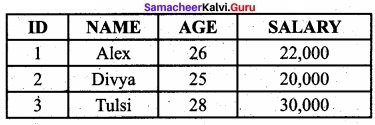
Column:
The table consists of several rows and columns. Table can be divided into smaller parts, in ‘ terms of columns. Each column is known as attributes. In the Employee table four attributes are available namely Id, Name, Age and Salary. The attribute is defined in a table to hold values of same type. This is known as Attribute Domain. In the Employee table, the Name field will hold only characters not the numbers in it. The vertical entity in a table is known as Attribute or Column.
Row:
A single entry in a table is called as Row or Record or Tuple. Set of related data’s are represented in a row or tuple. The horizontal entity in a table is known as Record or row.
Row Structure

Primary key:
The candidate key that is chosen to perform the identification task is called the primary key and any others are Alternate keys. Every tuple must have, by definition, a unique value for its primary key. A primary key which is a combination of more than one attribute is called a composite primary key.
Foreign Key:
A foreign key is a “copy” of a primary key that has been exported from one relation into another to represent the existence of a relationship between them. A foreign key is a copy of the whole of its parent primary key he if the primary key is composite, then so is the foreign key. Foreign key values do not (usually) have to be unique. Foreign keys can also
be null. A composite foreign key cannot have some attribute(s) null and others non-null.
Super Key:
An attribute or group of attributes, which is sufficient to distinguish every tuple in the relation from every other oiie is known as Super Key. Each super key is called a candidate key. A candidate key is selected from the set of Super Key. While selecting candidate key, redundant attributes should not be taken. The candidate key is also known as minimal super keys.
Composite Key:
A key with more than one attribute to identify rows uniquely in a table is called Composite key. This is also known as Compound Key.
![]()
Question 2.
Explain ER – Modeling diagram Notations?
Answer:
Entities, Attributes and Relationship forms the components of ER Diagram and the defined symbols and shapes are summarized below in Table.
ER diagram Notations.
